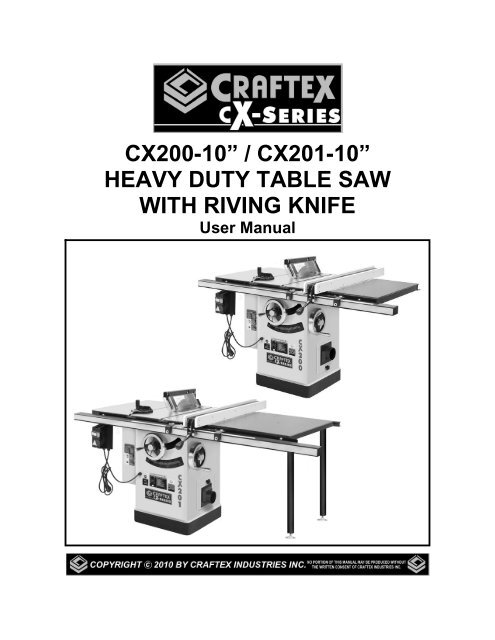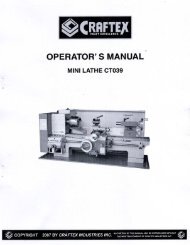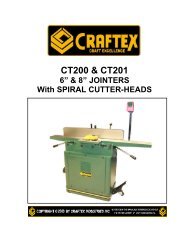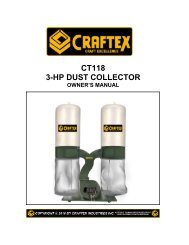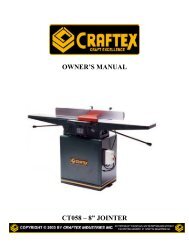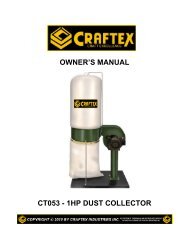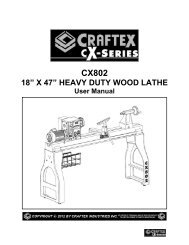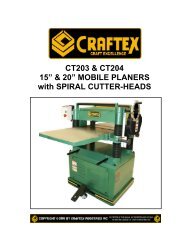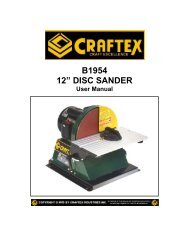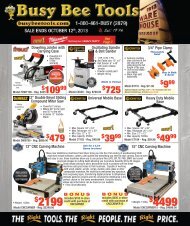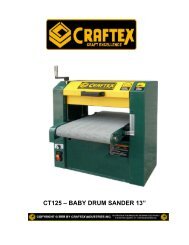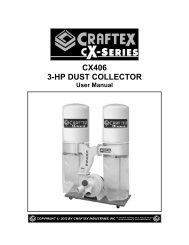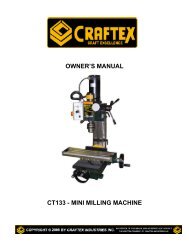heavy duty table saw with riving knife - Busy Bee Tools
heavy duty table saw with riving knife - Busy Bee Tools
heavy duty table saw with riving knife - Busy Bee Tools
Create successful ePaper yourself
Turn your PDF publications into a flip-book with our unique Google optimized e-Paper software.
CX200-10” / CX201-10”<br />
HEAVY DUTY TABLE SAW<br />
WITH RIVING KNIFE<br />
User Manual
TABLE OF CONTENTS<br />
General Safety Instructions.....................................................................................3<br />
Specific Safety Instructions.....................................................................................4<br />
CX200 Features......................................................................................................5<br />
CX201 Features......................................................................................................6<br />
Physical Features ...................................................................................................7<br />
Set Up.....................................................................................................................8<br />
Un-Packing & Inventory ..........................................................................................8<br />
Proper Grounding ...................................................................................................10<br />
Assembly ................................................................................................................11<br />
CX200 Extension Table ..........................................................................................13<br />
CX201 Extension Table ..........................................................................................14<br />
Installing the Saw Blade..........................................................................................15<br />
Fence Scale............................................................................................................15<br />
Blade Guard Installation..........................................................................................16<br />
Connecting to a Dust Collector ...............................................................................16<br />
Basic Controls.........................................................................................................17<br />
Test Run .................................................................................................................17<br />
Blade Guard............................................................................................................18<br />
Riving Knife.............................................................................................................18<br />
Work-Piece Inspection ............................................................................................19<br />
Operations ..............................................................................................................19<br />
Through Cuts ..........................................................................................................19<br />
Non-Through Cuts ..................................................................................................19<br />
Ripping....................................................................................................................20<br />
Crosscutting............................................................................................................20<br />
Miter Cuts ...............................................................................................................21<br />
Bevel Cuts ..............................................................................................................21<br />
Adjustments ............................................................................................................22<br />
Main Table to Blade Parallelism..............................................................................22<br />
Blade Guard Spreader & Riving Knife Alignment....................................................22<br />
Tensioning the V-belt ..............................................................................................23<br />
Replacing the V-Belts .............................................................................................24<br />
Maintenance ...........................................................................................................24<br />
Parts Breakdown & List.......................................................................................25-37<br />
Warranty .................................................................................................................38<br />
2
GENERAL SAFETY INSTRUCTIONS<br />
FOR MACHINES<br />
Extreme caution should be used when operating all power tools. Know your power<br />
tool, be familiar <strong>with</strong> its operation, read through the owner’s manual and practice safe<br />
usage procedures at all times.<br />
ALWAYS read and understand the<br />
user manual before operating the<br />
machine.<br />
CONNECT your machine ONLY to the<br />
matched and specific power source.<br />
ALWAYS wear safety glasses<br />
respirators, hearing protection and<br />
safety shoes, when operating your<br />
machine.<br />
DO NOT wear loose clothing or<br />
jewelry when operating your machine.<br />
A SAFE ENVIRONMENT is<br />
important. Keep the area free of dust,<br />
dirt and other debris in the immediate<br />
vicinity of your machine.<br />
BE ALERT! DO NOT use prescription<br />
or other drugs that may affect your<br />
ability or judgment to safely use your<br />
machine.<br />
DISCONNECT the power source when<br />
changing drill bits, hollow chisels,<br />
router bits, shaper heads, blades,<br />
knives or making other adjustments or<br />
repairs.<br />
NEVER leave a tool unattended while it<br />
is in operation.<br />
NEVER reach over the <strong>table</strong> when the<br />
tool is in operation.<br />
ALWAYS keep blades, knives and bits<br />
sharpened and properly aligned.<br />
ALL OPERATIONS MUST BE<br />
performed <strong>with</strong> the guards in place to<br />
ensure safety.<br />
ALWAYS use push sticks, feather<br />
boards or other safety devices to safely<br />
feed your work through the machine.<br />
ALWAYS make sure that any tools used<br />
for adjustments are removed before<br />
operating the machine.<br />
ALWAYS keep the bystanders safely<br />
away while the machine is in operation.<br />
NEVER attempt to remove jammed<br />
cutoff pieces until the <strong>saw</strong> blade has<br />
come to a full stop.<br />
3
CX200/CX201<br />
SPECIFIC SAFETY INSTRUCTIONS<br />
NEVER use a <strong>saw</strong> blade that has<br />
missing carbide teeth, loose teeth, or<br />
chipped or broken teeth.<br />
NEVER stand directly in line <strong>with</strong> the<br />
<strong>saw</strong> blade when feeding stock into the<br />
<strong>saw</strong>.<br />
NEVER place your fingers or hands in<br />
the line of cut. If you slip, your hands<br />
or fingers may come into contact <strong>with</strong><br />
the blade. Always use a push stick<br />
when ripping narrow pieces.<br />
NEVER allow visitors or helpers to<br />
stand in line <strong>with</strong> the <strong>saw</strong> blade.<br />
ALL GUARDS must be in place while<br />
operating the <strong>table</strong> <strong>saw</strong> to ensure<br />
safety.<br />
ALWAYS feed the stock smoothly. Do<br />
not force or twist the work-piece while<br />
cutting.<br />
NEVER allow anyone to “assist” you<br />
by holding your work-piece at the outfeed<br />
end.<br />
MAKE SURE before making any<br />
adjustments, the switch is in the “OFF”<br />
position and the cord is un-plugged.<br />
NEVER LEAVE the <strong>table</strong> <strong>saw</strong><br />
unattended while it is running.<br />
DO NOT attempt to remove jammed<br />
pieces unless the <strong>table</strong> <strong>saw</strong> has come to<br />
a complete stop and the power switch<br />
has been turned to the OFF position and<br />
cord is unplugged.<br />
NEVER attempt to cut stock “freehand”,<br />
always use the rip fence or miter gauge.<br />
ALWAYS make sure that the rip fence<br />
is properly squared to the <strong>saw</strong> blade to<br />
prevent kickback.<br />
ALWAYS make sure that your <strong>saw</strong> is in<br />
a s<strong>table</strong> position. Cutting <strong>heavy</strong> or long<br />
stock may alter the stability of the <strong>saw</strong>.<br />
In the event that this may occur, make<br />
sure that the <strong>saw</strong> should be firmly bolted<br />
to the floor.<br />
ALWAYS be sure that if using a mobile<br />
base, wheels are firmly locked before<br />
turning the <strong>saw</strong> on.<br />
ALWAYS use a feather board and/or<br />
hold-downs to support your work-piece<br />
when necessary.<br />
MAKE SURE you have read and<br />
understood all the safety instructions in<br />
the manual and you are familiar <strong>with</strong><br />
your <strong>table</strong> <strong>saw</strong>, before operating it. If<br />
you fail to do so, serious injury could<br />
occur.<br />
WARNING<br />
The safety instructions given above can not be complete because the environment in<br />
every shop is different. Always consider safety first as it applies to your individual<br />
working conditions.<br />
4
CX200–10” Table Saw<br />
FEATURES<br />
MODEL CX200 – 10” TABLE SAW WITH RIVING KNIFE<br />
As part of the growing line of Craftex woodworking equipment, we are proud to offer the<br />
CX200 a 10” Table Saw <strong>with</strong> Riving Knife. The Craftex name guarantees Craft Excellence. By<br />
following the instructions and procedures laid out in this user manual, you will receive years of<br />
excellent service and satisfaction. The CX200 is a professional tool and like all power tools,<br />
proper care and safety procedures should be adhered to.<br />
Motor ..............................................3-HP, 220-V, Single Phase TEFC Motor<br />
Drive System ..................................Triple “V” Belt Drive<br />
Blade Guard ...................................Riving Knife, CSA Approved & UL897 Compliant<br />
Miter Gauge....................................T-Slot Miter Gauge<br />
Rip Fence .......................................“T” Type Heavy Duty Rip Fence (Cam Lever) w/Optical Cursor<br />
Fence Size......................................Length 48” x Width 4-1/8” x Height 2-1/2”<br />
Table Size.......................................Length 40” x Width 27” (<strong>with</strong> Extension Wings)<br />
Floor to Table Height ......................34”<br />
Maximum Blade Diameter ..............10”<br />
Riving Knife/Spreader Thickness....0.1”<br />
Arbor Size.......................................5/8”<br />
Arbor Speed ...................................4300 RPM<br />
Maximum Width of Dado ................13/16”<br />
Maximum Depth of Cut @ 90°........3-1/8”<br />
Maximum Depth of Cut @ 45°........2-3/16”<br />
Maximum Rip to Right of Blade ......30”<br />
Maximum Rip to Left of Blade.........12”<br />
Dust Collection Ports ......................One 4” Port<br />
Dimensions.....................................Length 62” x Width 41” x Height 40”<br />
Approximate Weight .......................550 lbs.<br />
5
CX201–1” Table Saw<br />
FEATURES<br />
MODEL CX201 – 10” TABLE SAW WITH 50” RAILS & EXTENSION TABLE<br />
As part of the growing line of Craftex woodworking equipment, we are proud to offer the<br />
CX201 a 10” Table Saw <strong>with</strong> 50” Rails, Riving Knife and Extension Table. The Craftex name<br />
guarantees Craft Excellence. By following the instructions and procedures laid out in this user<br />
manual, you will receive years of excellent service and satisfaction. The CX201 is a<br />
professional tool and like all power tools, proper care and safety procedures should be<br />
adhered to.<br />
Motor ..............................................3-HP, 220-V, 12.8 Amp, Single Phase TEFC Motor<br />
Drive System ..................................Triple “V” Belt Drive<br />
Blade Guard ...................................Riving Knife, CSA Approved & UL897 Compliant<br />
Miter Gauge....................................T-Slot Miter Gauge<br />
Rip Fence .......................................“T” Type Heavy Duty Rip Fence (Cam Lever) w/Optical Cursor<br />
Fence Size......................................Length 48” x Width 4-1/8” x Height 2-1/2”<br />
Table Size.......................................Length 73-3/4” x Width 27” (<strong>with</strong> Extension Wings)<br />
Floor to Table Height ......................34”<br />
Maximum Blade Diameter ..............10”<br />
Riving Knife/Spreader Thickness....0.1”<br />
Arbor Size.......................................5/8”<br />
Arbor Speed ...................................4300 RPM<br />
Maximum Width of Dado ................13/16”<br />
Maximum Depth of Cut @ 90°........3-1/8”<br />
Maximum Depth of Cut @ 45°........2-3/16”<br />
Maximum Rip to Right of Blade ......50”<br />
Maximum Rip to Left of Blade.........12”<br />
Dust Collection Ports ......................One 4” Port<br />
Dimensions.....................................Length 82” x Width 41” x Height 40”<br />
Approximate Weight .......................590 lbs.<br />
6
CX200/CX201 – Heavy Duty Table Saw<br />
Physical Features<br />
Miter<br />
Gauge<br />
Blade<br />
Guard<br />
Fence<br />
Front<br />
Fence Rail<br />
Extension<br />
Table<br />
Rear<br />
Fence Rail<br />
Blade Tilt<br />
Hand Wheel<br />
Blade Height<br />
Hand Wheel<br />
Blade Height<br />
Lock<br />
Blade Tilt<br />
Lock<br />
Extension<br />
Table<br />
Legs<br />
ON / OFF<br />
Magnetic<br />
Switch<br />
Motor<br />
Cover<br />
Power<br />
Cord<br />
4” Dust<br />
Port<br />
Table Tilt<br />
Scale<br />
7
SETUP<br />
Before setting up your machine you should<br />
read and understand the instructions given<br />
in this manual.<br />
The unpainted surfaces of this <strong>table</strong> <strong>saw</strong><br />
are coated <strong>with</strong> a rust preventive waxy oil<br />
and you will want to remove this before you<br />
begin assembly. Use a solvent cleaner that<br />
will not damage painted surfaces.<br />
LIST OF CONTENST<br />
QTY<br />
A. Table Saw........................................ 1<br />
B. Extension Wings .............................. 2<br />
C. Cabinet Door.................................... 1<br />
D. Fence............................................... 1<br />
E. Fence Rails & Tube ......................... 3<br />
F. 10” Blade ......................................... 1<br />
G. Magnetic Switch............................... 1<br />
WARNING<br />
CX200/CX201 is a very <strong>heavy</strong> machine,<br />
do not over-exert yourself. For safe<br />
moving method use fork truck or get the<br />
help of an assistant or friend.<br />
UNPACKING<br />
The machine is properly packaged and<br />
shipped completely in crates for safe<br />
transportation. When unpacking, carefully<br />
inspect the crates and ensure that nothing<br />
has been damaged during transit. Open the<br />
crates and check that the machine and the<br />
parts are in good condition.<br />
Figure-2 Inventory<br />
LIST OF CONTENTS<br />
QTY<br />
H. Table Insert...................................... 1<br />
I. Blade Guard & Spreader.................. 1<br />
J. Push Stick........................................ 1<br />
K. Miter Gauge ..................................... 1<br />
L. Riving Knife...................................... 1<br />
M. Hand Wheel ..................................... 2<br />
N. Hand Wheel Lock............................. 2<br />
O. Hand Wheel Handle......................... 2<br />
P. Dust Port.......................................... 1<br />
Q. Hardware Bag.................................. 1<br />
R. Fence Rail Tape Scale..................... 1<br />
Figure-1 Inverntory<br />
8
CX200 & CX201<br />
EXTENSION TABLE<br />
While doing inventory, if you can not find<br />
any part, check if the part is already<br />
installed on the machine. Some of the parts<br />
come assembled <strong>with</strong> the machine because<br />
of shipping purposes.<br />
When setting up your machine, you will<br />
want to find an ideal spot where your <strong>table</strong><br />
<strong>saw</strong> will most likely be positioned most of<br />
the time. Consider your complete work<br />
environment as well as working<br />
comfortability <strong>with</strong> the <strong>table</strong> <strong>saw</strong> before<br />
placing your machine in the ideal spot.<br />
Figure-3 Inventory<br />
LIST OF CONTENTS<br />
QTY<br />
S. Extension Wing (CX201) ................. 1<br />
T. Legs (CX201) .................................. 2<br />
U. Foot Pads........................................ 2<br />
V. Extension Wing (CX200) ................. 1<br />
Figure-4 Minimum working space for<br />
CX200 & CX201<br />
9
PROPER GROUNDING<br />
Grounding provides a path of least<br />
resistance for electric current to reduce the<br />
risk of electric shock.<br />
CX200/CX201 is equipped <strong>with</strong> a 220-V<br />
single phase motor.<br />
To prevent electrical hazards, have a<br />
qualified electrician ensure that the line is<br />
properly wired.<br />
This appliance is for use on a circuit having<br />
a normal of 220 volts. Make sure that the<br />
appliance is connected to an outlet having<br />
the same configuration as the plug. If an<br />
adaptor plug is used, it must be attached to<br />
the metal screw of the receptacle.<br />
WARNING<br />
Improper connection of the equipmentgrounding<br />
conductor can result in a risk<br />
of electric shock. Check <strong>with</strong> a qualified<br />
electrician if you are in doubt as to<br />
whether the outlet is properly grounded.<br />
It is strongly recommended not to use<br />
extension cords <strong>with</strong> your CX200/CX201.<br />
Always try to position your machine close to<br />
the power source so that you do not need<br />
to use extension cords.<br />
Incase if you really find it necessary to use<br />
an extension cord, make sure the extension<br />
cord does not exceed 50-feet in length and<br />
the cord is 14-gauge to prevent motor<br />
damage.<br />
Your CX200/CX201 should be wired <strong>with</strong> a<br />
plug having 3-prongs to fit a 3 prong<br />
grounding receptacle as shown in figure-5.<br />
Do not remove the grounding prong to fit it<br />
into a 2-pronged outlet. Always check <strong>with</strong><br />
a qualified electrician if you are in doubt.<br />
Figure-5 220-Volts Outlet for CX200/CX201<br />
10
ASSEMBLY<br />
To assemble your CX200/201, read and<br />
understand the text and figures given.<br />
Take the magnetic switch out of the <strong>saw</strong><br />
cabinet and loosen the bolt securing the<br />
shipping brace, and remove the brace.<br />
Reinstall the bolt and washers and save the<br />
shipping brace.<br />
Install the blade tilt hand wheel onto the<br />
hand wheel shaft and secure it using set<br />
screw provided. See figure-8.<br />
Figure-8 Securing the blade tilt hand wheel<br />
Now, thread the hand wheel lock into the<br />
center of the hand wheel and tighten it.<br />
Figure-6 Shipping brace location<br />
Thread the hand wheel handle onto the<br />
hand wheel and tighten using a proper size<br />
wrench.<br />
Attach the cabinet door by inserting the<br />
door pins into the hinge sockets on the<br />
cabinet. See figure-7.<br />
Figure-9 Hand wheel lock and handle<br />
installed<br />
Figure-7 Installing the cabinet door<br />
Install the blade height hand wheel in the<br />
same manner.<br />
11
Attach the dust port to the <strong>saw</strong> and secure<br />
it using the knob as shown in figure-10.<br />
Place a straight-edge on the main <strong>table</strong> and<br />
the extension wing, and make sure they are<br />
flat <strong>with</strong> each other.<br />
If the mating surface of the extension wing<br />
tilts down, use a masking tape along the<br />
bottom edge of the main <strong>table</strong> to shim the<br />
extension wing up.<br />
Figure-10 Installing the dust port<br />
Remove the screws and washers from the<br />
edges of the main <strong>table</strong> and inspect the<br />
mating surfaces of the extension <strong>table</strong> and<br />
main <strong>table</strong> for any foreign material that can<br />
cause misalignment when assembled.<br />
Make sure the mating surfaces of the main<br />
<strong>table</strong> and the extension wings are clean<br />
and attach the extension wings to the <strong>table</strong><br />
<strong>with</strong> the help of an assistant holding the<br />
<strong>table</strong>. Secure it using cap screws and<br />
washers provided. See figure 11.<br />
Figure-12 Using masking tape to shim the<br />
extension wing up<br />
If the mating surface of the extension wing<br />
tilts up, use a masking tape along the top<br />
edge if the main <strong>table</strong> to shim the extension<br />
wing down.<br />
Figure-13 Using masking tape to shim the<br />
extension wing down<br />
Figure-11 Installing the extension wings<br />
When the <strong>table</strong> is reinstalled, remove the<br />
excessive masking tape using a blade.<br />
12
Attach the front fence rail to the <strong>table</strong> and<br />
the extension wing using nuts, bolts and<br />
washers provided. See figure-14.<br />
Figure-16 Installing rear fence rail<br />
Figure-14 Installing front fence rail<br />
Now, install the fence rail tube onto the<br />
front rail using cap screws, washers and flat<br />
washers provided. See figure-15.<br />
CX200 EXTENSION TABLE<br />
Install the extension <strong>table</strong> between the front<br />
and rear fence rails, securing it to the rails<br />
using hex nuts, hex bolts and washers<br />
provided.<br />
Figure-15 Installing the fence rail tube<br />
Attach the rear fence rail to the extension<br />
wings and the main <strong>table</strong> and secure it<br />
using hex bolts and washers provided. See<br />
figure-16. Make sure the top edge of the<br />
rear rail is flush <strong>with</strong> the bottom part of the<br />
T-slots on the <strong>table</strong>.<br />
Figure-17 Installing the extension <strong>table</strong> for<br />
CX200<br />
Place a straight-edge across the extension<br />
wing and the extension <strong>table</strong> and adjust the<br />
extension <strong>table</strong> so that it is flush <strong>with</strong> the<br />
extension wings and the main <strong>table</strong>.<br />
13
CX201 EXTENSION TABLE<br />
Get an assistant to hold the extension <strong>table</strong><br />
between the front and rear fence rails.<br />
Secure the extension <strong>table</strong> to the rails using<br />
hex bolts, hex nuts and washers provided<br />
<strong>with</strong> the extension <strong>table</strong>.<br />
Thread the foot pads into the legs as shown<br />
in figure 18 and do not tighten the jam nut<br />
at this time.<br />
Place a straight-edge across the extension<br />
wings and the extension <strong>table</strong> and level the<br />
extension <strong>table</strong> by adjusting the feet, so<br />
that the extension is flush <strong>with</strong> the<br />
extension wings and the main <strong>table</strong>.<br />
Once the <strong>table</strong> surfaces are flush <strong>with</strong> each<br />
other, tighten the hex nuts on the feet up,<br />
against the leg to lock the feet.<br />
To install the fence, place it on the rails, on<br />
the right hand side of the blade and push<br />
the fence handle down to lock the fence on<br />
the rails.<br />
Figure-18 Connecting legs to each other<br />
Place the legs under the <strong>table</strong> and adjust<br />
the feet until the <strong>table</strong> sits properly on both<br />
legs and tighten the jam nut Secure the<br />
legs to the end of the <strong>table</strong> using cap<br />
screws and washers provided. See figure-<br />
19.<br />
Figure-20 Installing the fence on the rails<br />
Attach the magnetic switch to the front rail<br />
and secure it using screws and washers.<br />
Figure-19 Installing CX201 extension <strong>table</strong><br />
Figure-21 Installing the magnetic switch<br />
14
INSTALLING THE SAW BLADE<br />
Remove the screw securing the <strong>table</strong> insert<br />
to the <strong>table</strong> and remove the <strong>table</strong> insert.<br />
Raise the arbor all the way up using the<br />
blade height hand wheel located on the<br />
front of the <strong>saw</strong> and set the blade to 0-<br />
degree.<br />
Remove the arbor nut and the arbor flange<br />
and install the 10” blade provided. Make<br />
sure the teeth of the blade are facing the<br />
front of the <strong>saw</strong>. Install the arbor flange<br />
and the arbor nut and tighten using arbor<br />
wrenches provided.<br />
pointer window and re-install it on the right<br />
side of the fence.<br />
Figure-23 Installing pointer window<br />
To Install the Fence Scale:<br />
Slide the fence against the <strong>saw</strong> blade and<br />
push the fence handle down to lock it on<br />
the rails.<br />
Figure-22 Installing the blade<br />
FENCE SCALE<br />
Before installing the fence scale on the rail<br />
tube, determine whether you want to use<br />
the pointer window to the right or left side of<br />
the fence.<br />
It is recommended to mount the pointer<br />
window to the right side of the fence so that<br />
the work-piece does not cover the pointer<br />
window while cutting operation.<br />
If the machine comes <strong>with</strong> the pointer<br />
window mounted to the left side of the<br />
fence, simply loosen the screws on the<br />
Place the tape scale on the fence and make<br />
sure the “0” is aligned <strong>with</strong> the red line on<br />
the pointer window, and mark the “0” on the<br />
fence tube <strong>with</strong> a pencil.<br />
Remove the fence and peel off the tape.<br />
Align the “0” mark on the tape scale <strong>with</strong><br />
the pencil mark on the tube and attach the<br />
tape scale on the tube.<br />
IMPORTANT<br />
To get accurate cuts, it is very important<br />
to attach the tape scale on the fence<br />
tube, aligning the “0” perfectly <strong>with</strong> the<br />
pencil mark that you made.<br />
Adjust the pointer window if required by<br />
loosening the two screws holding the<br />
pointer window to the fence and position it<br />
left or right.<br />
15
INSTALLING BLADE GUARD<br />
Install the <strong>table</strong> insert and slide the knurled<br />
knob out, rotating it forward so that it<br />
engages the upper bracket.<br />
CONNECTING TO A DUST<br />
COLLECTOR<br />
CX200/CX201 features a 4” diameter dust<br />
port to connect to a dust collector.<br />
When connecting to a dust collector, use a<br />
proper sized hose and make sure all the<br />
connections are sealed tightly.<br />
It is recommended to use a proper sized<br />
dust collector <strong>with</strong> the CX200/CX201 to<br />
ensure adequate dust collection.<br />
Figure-24 Using knurled knob to secure the<br />
spreader<br />
Now, slide the blade guard spreader, down<br />
into the adjustment block and rotate the<br />
knurled knob to disengage the bracket. The<br />
locking pin engages the hole in the center<br />
of the spreader. Make sure the spreader is<br />
locked properly.<br />
The blade guard should move freely and<br />
touch the <strong>table</strong> surface and should swing<br />
high enough to allow the work-piece fed<br />
easily while cutting operation.<br />
Figure-26 Connecting to a dust collector<br />
WARNING<br />
The fine dust particles produced by the<br />
<strong>table</strong> <strong>saw</strong> can go into your lungs and<br />
cause serious respiratory problems.<br />
Make sure to wear a dust mask and<br />
connect the <strong>table</strong> <strong>saw</strong> to a proper dust<br />
collection system while operating it.<br />
Figure-25 Blade guard installed<br />
16
BASIC CONTROLS<br />
The basic controls of this machine are<br />
shown in the figure-27. Use the figure and<br />
read the text to understand what the basic<br />
controls of your CX200/CX201 are.<br />
TEST RUN<br />
Once you have assembled your machine<br />
completely, it is then time for a test run to<br />
make sure that the machine works properly<br />
and is ready for operation.<br />
During the test run if there is any unusual<br />
noise coming from the machine or the<br />
machine vibrates excessively, stop the<br />
machine immediately and disconnect from<br />
the power source and investigate to find out<br />
the problem <strong>with</strong> your machine.<br />
Figure-27 Basic controls on CX200/CX201<br />
Magnetic Switch<br />
The magnetic switch on your CX200/CX201<br />
has a green button to turn the machine<br />
“ON” and a red button to turn the machine<br />
“OFF”, when pressed.<br />
Blade Height Hand Wheel<br />
It is used to raise and lower the blade. The<br />
hand wheel features a locking knob at its<br />
center, which is used to lock the hand<br />
wheel. If you want to adjust the blade<br />
height, loosen the hand wheel lock and turn<br />
the hand wheel. When the blade is at the<br />
desired height, tighten the lock.<br />
Blade Tilt Hand Wheel<br />
It is used to adjust the angle of the blade.<br />
The hand wheel features a lock in its<br />
center, which is used to lock the hand<br />
wheel. If you want to adjust the blade angle,<br />
loosen the locking knob and turn the hand<br />
wheel. When the blade is at the desired<br />
angle, tighten the lock.<br />
READ THE<br />
MANUAL<br />
Before starting the <strong>table</strong> <strong>saw</strong>, make sure<br />
that you have read and understood the<br />
manual and you are familiar <strong>with</strong> the<br />
functions and safety features on this<br />
machine. Failure to do so may cause<br />
serious personal injury.<br />
During the test run you should make sure<br />
that the machine operates properly when<br />
turned ON. Check all the safety features on<br />
the machine and make sure all the safety<br />
features work properly.<br />
WARNING<br />
The safety instructions given in this<br />
manual can not be complete because the<br />
environment in every shop is different.<br />
Always consider safety first as it applies<br />
to your individual working conditions.<br />
17
BLADE GUARD<br />
The blade guard assembly on your<br />
CX200/CX201 consists of a clear<br />
polycarbonate shield, spreader and antikickback<br />
pawls.<br />
The clear polycarbonate guard allows the<br />
operator to see the blade cutting the workpiece<br />
during cutting operation. The guard<br />
covers the blade on both sides and lifts up<br />
as the work-piece is fed into the blade and<br />
returns to the <strong>table</strong> surface when the workpiece<br />
has passed through the blade. It<br />
prevents the wood chips to fly and injure<br />
the operator and it also prevents from<br />
accidental contacts of objects <strong>with</strong> the<br />
blade.<br />
At the back side of the guard there is a<br />
metal plate called a spreader. The spreader<br />
prevents the kerf of the work-piece from<br />
pinching the blade and causing kick back.<br />
The kick back pawls are designed such that<br />
they allow the work-piece to move only<br />
forward. During the cutting operation if the<br />
work-piece moves backward, the anti kick<br />
back pawls will dig into it and stop it.<br />
RIVING KNIFE<br />
The <strong>riving</strong> <strong>knife</strong> is a metal plate which<br />
prevents the newly cut work-piece from<br />
pinching at the backside of the blade and<br />
causing kickback. Basically the <strong>riving</strong> <strong>knife</strong><br />
does the same job as the spreader. But the<br />
main difference is that the <strong>riving</strong> <strong>knife</strong> is<br />
installed below the blade height while the<br />
spreader is installed higher than the blade.<br />
Figure-29 Riving <strong>knife</strong><br />
The <strong>riving</strong> <strong>knife</strong> is installed when doing nonthrough<br />
cuts using a standard <strong>table</strong> <strong>saw</strong><br />
blade and for the cutting operations when<br />
the blade does not cut all the way through<br />
thickness of the work-piece.<br />
WARNING<br />
DO NOT use the <strong>riving</strong> <strong>knife</strong> <strong>with</strong> dado<br />
blades. If used, the <strong>riving</strong> <strong>knife</strong> will be<br />
higher than the dado blade and the workpiece<br />
will hit the <strong>riving</strong> <strong>knife</strong>.<br />
Height Difference:<br />
Figure-28 Blade guard assembly<br />
The <strong>riving</strong> <strong>knife</strong> should be installed <strong>with</strong><br />
1mm to 5mm height difference <strong>with</strong> the<br />
blade height. It is recommended to keep<br />
3mm to 8mm distance between the blade<br />
(from the carbide tip) and the <strong>riving</strong> <strong>knife</strong>.<br />
18
WORK-PIECE INSPECTION<br />
Before cutting the work-piece, make sure to<br />
inspect it for nails, staples, small pieces of<br />
stone or metal and any other object which<br />
is dangerous to come on contact <strong>with</strong> the<br />
blade.<br />
If the wood contains any of these objects<br />
and it comes in contact <strong>with</strong> the blade, the<br />
object might fly and hit the operator or<br />
seriously damage the blade. For a safe<br />
cutting method always inspect your workpiece<br />
carefully before cutting and wear eye<br />
protection.<br />
Some woods <strong>with</strong> excessive twisting or<br />
wrapping are un-s<strong>table</strong> while cutting. This<br />
situation can be dangerous, because during<br />
operation the work-piece can move unexpectedly<br />
which can either damage the<br />
blade or hurt the operator.<br />
If the wood is slightly cupped, make sure<br />
the cupped face of the wood is held against<br />
the <strong>table</strong> or the fence. If the bowed side of<br />
the work-piece is held against the <strong>table</strong> or<br />
the fence, there will be a great possibility<br />
that the work-piece move unexpectedly<br />
while cutting, and cause kickback or injury<br />
to the operator.<br />
Some stock <strong>with</strong> large knots can damage<br />
the blade and wet stock will give a poor<br />
result.<br />
WARNING<br />
The information above is just a guideline<br />
for you to understand how to cut a workpiece<br />
<strong>with</strong> slight cupping. If you are not<br />
sure and do not have any experience in<br />
cutting cupped stock, do not cut it.<br />
Failure to follow these instructions might<br />
bring personal injuries to the operator or<br />
serious damage to the blade.<br />
OPERATIONS<br />
Before doing the operation, make sure all<br />
the parts of the machine are assembled<br />
properly and you have done the test run.<br />
Make sure you have read the manual and<br />
you are familiar using the <strong>table</strong> <strong>saw</strong>,<br />
knowing all the safety features on this<br />
machine.<br />
THROUGH CUTS<br />
The operation, in which the <strong>saw</strong> blade cuts<br />
the work-piece completely, is called through<br />
cut. Ripping, cross cuts, miter cuts and<br />
beveled cuts are examples of through cuts.<br />
Figure-30 Shows an example of through cut<br />
For clarity the blade guard assembly is not<br />
shown in figure-30 but for your safety it is<br />
highly recommended to use blade guard<br />
when performing through cuts.<br />
NON-THROUGH CUT<br />
The operation, in which the work-piece is<br />
passed over the <strong>saw</strong> blade and it does not<br />
cut the work-piece all the way through its<br />
thickness, is called non-through cut.<br />
19
Since the blade guard can not be used<br />
when doing non-through cuts, there is great<br />
possibility of kickback. Make sure to have<br />
the <strong>riving</strong> <strong>knife</strong> installed, when using<br />
standard <strong>saw</strong> blade to perform non-through<br />
cuts.<br />
reach the full speed and feed the workpiece<br />
through the blade using a push stick,<br />
until the work-piece completely passes the<br />
<strong>saw</strong> blade. See figure-32.<br />
Figure-31 shows an example of nonthrough<br />
cut <strong>with</strong> standard <strong>saw</strong> blade<br />
For clarity figure-31 does not show <strong>riving</strong><br />
<strong>knife</strong>, but it is highly recommended to install<br />
the <strong>riving</strong> <strong>knife</strong> when performing nonthrough<br />
cuts <strong>with</strong> standard <strong>saw</strong> blade.<br />
RIPPING<br />
Cutting solid wood <strong>with</strong> the grain and<br />
cutting down the length of the work-piece is<br />
called ripping.<br />
With the power “OFF”, adjust the fence on<br />
the rails according to the desired width of<br />
the cut. Turn the <strong>table</strong> height hand-wheel to<br />
set the guide post assembly 1/4” above the<br />
work-piece. Make sure that blade guard<br />
assembly is working properly and install<br />
other safety devices like feather board, if<br />
needed.<br />
Connect the cord to the power source and<br />
turn the <strong>table</strong> <strong>saw</strong> “ON”. Let the blade to<br />
Figure-32 Ripping operation<br />
After the work-piece is cut, let the blade<br />
come to a complete stop and then remove<br />
the cut-off pieces.<br />
WARNING<br />
Do not use your fingers to feed narrow<br />
work-pieces into the blade. Always use a<br />
push stick to prevent the possibility of<br />
injury.<br />
CROSSCUTTING<br />
Cutting solid wood across the grain and<br />
cutting plywood across the width of the<br />
work-piece is called cross-cutting.<br />
Remove the fence and mark the work-piece<br />
where you want to start the cut from and<br />
make sure the miter guide is at 90° position<br />
on the miter slot. Place the work-piece on<br />
the <strong>table</strong> so that the marked point is aligned<br />
20
<strong>with</strong> the blade and the blade is cutting the<br />
waste side of the line.<br />
Connect the cord to the power source and<br />
turn the <strong>table</strong> <strong>saw</strong> “ON”. Let the blade to<br />
reach its full speed and hold the work-piece<br />
against the face of the miter gauge. Slowly<br />
push the work-piece <strong>with</strong> the miter gauge<br />
and until it is completely past the blade. Let<br />
the blade come to a complete stop and<br />
remove the cut-off work-pieces.<br />
Figure-34 Marking the angle of cut<br />
BEVEL CUTS<br />
The CX200/CX201 blade can be tilted to<br />
the left between 0° and 45° by rotating the<br />
blade tilt hand wheel. This feature of the<br />
<strong>saw</strong> allows making bevel cuts.<br />
Figure-33 Crosscutting operation<br />
MITER CUTS<br />
Miter cut is an angled crosscut performed in<br />
the same manner as crosscut, using miter<br />
gauge.<br />
Place the face of the miter gauge against<br />
the edge of the work-piece and miter gauge<br />
bar across the face of the work-piece. Use<br />
the bar as a guide and mark the angle of<br />
cut <strong>with</strong> a pencil as shown in figure-34.<br />
Place the miter gauge back into the T-slot<br />
and hold the work-piece against the face of<br />
the miter gauge. Push the work-piece <strong>with</strong><br />
the miter gauge slowly against the blade<br />
until the work-piece is completely past the<br />
blade.<br />
To make bevel cuts, rotate the blade tilt<br />
hand wheel to the desired angle, looking at<br />
the tilt scale and lock the hand wheel by<br />
tightening the lock at the center of the hand<br />
wheel.<br />
After that, proceed to make the cut in the<br />
same manner as in “Cross Cutting”. See<br />
page-20.<br />
For more accurate cuts angles,<br />
use a digital angle finder.<br />
Model# B2646<br />
Model# WR300<br />
21
ADJUSTMENTS<br />
MAIN TABLE TO BLADE<br />
PARALLELISM<br />
Your CX200/CX201 will give a better result<br />
if the main <strong>table</strong> is parallel to the blade. If it<br />
is not parallel, the result you will get will be<br />
poor and low quality.<br />
To check if the <strong>table</strong> is parallel to the blade,<br />
use an adjus<strong>table</strong> square and measure the<br />
distance between the miter slot on the <strong>table</strong><br />
and the edge of the blade (front or back) as<br />
shown in figure-35.<br />
To adjust the <strong>table</strong>:<br />
Make sure the switch is in the “OFF”<br />
position and the cord is unplugged from the<br />
power source.<br />
Loosen the four mounting bolts (shown in<br />
figure-36) securing the <strong>table</strong> on the cabinet<br />
and adjust the <strong>table</strong> to get equal<br />
measurements on both sides of the blade.<br />
Once the <strong>table</strong> is parallel to the blade, retighten<br />
the mounting bolts.<br />
Figure-36 Mounting bolts location<br />
Figure-35 Measuring the distance using an<br />
adjus<strong>table</strong> square<br />
Now, lock the square in place and mark the<br />
blade <strong>with</strong> a marker where you made the<br />
measurement. Rotate the blade so that the<br />
mark is opposite to the first position (front or<br />
back) and slide the square to check if the<br />
blade is at the same distance <strong>with</strong> the miter<br />
slot.<br />
The measurement should be equal on both<br />
sides. If the measurements are not the<br />
same, the <strong>table</strong> needs to be adjusted<br />
parallel to the blade.<br />
BLADE GUARD SPREADER &<br />
RIVING KNIFE ALIGNMENT<br />
The blade guard spreader and <strong>riving</strong> <strong>knife</strong><br />
must be aligned <strong>with</strong> the blade for safe and<br />
accurate cutting operation. If the blade<br />
guard spreader or the <strong>riving</strong> <strong>knife</strong> is not<br />
aligned <strong>with</strong> the blade, the work-piece will<br />
be pushed sideways during operation and<br />
increasing the risk of kick back.<br />
Make sure the switch is “OFF” and check<br />
the spreader or <strong>riving</strong> <strong>knife</strong> alignment using<br />
a straight-edge. Raise the blade to the<br />
maximum height using the blade height<br />
hand-wheel. Place the straight edge against<br />
the top and bottom part of the spreader or<br />
<strong>riving</strong> <strong>knife</strong> as shown in figure-37.<br />
22
To adjust the alignment:<br />
Turn “OFF” the <strong>table</strong> <strong>saw</strong> and remove the<br />
cord from the power source.<br />
Remove the <strong>table</strong> insert and loosen the two<br />
cap screws on the mounting block and<br />
adjust the set screws to move the<br />
spreader/<strong>riving</strong> <strong>knife</strong>.<br />
Figure-37 Using a straight-edge to check<br />
the top and bottom alignment<br />
If the spreader or <strong>riving</strong> <strong>knife</strong> is not parallel<br />
<strong>with</strong> the blade, remove it and place it on a<br />
flat surface. Check if it lays evenly on the<br />
flat surface along its length.<br />
If the spreader or <strong>riving</strong> <strong>knife</strong> does not lie<br />
evenly, bend it <strong>with</strong> your hands until it is<br />
straight.<br />
The spreader or <strong>riving</strong> <strong>knife</strong> mounting<br />
position can be adjusted by adjusting the<br />
set screws located on the spreader/<strong>riving</strong><br />
<strong>knife</strong> mounting block.<br />
The set screws are to control the top, side<br />
(left & right) and bottom adjustment of the<br />
spreader/<strong>riving</strong> <strong>knife</strong>.<br />
Adjust the two side screws to an equal<br />
amount to move the front of the spreader/<br />
<strong>riving</strong> <strong>knife</strong> left or right.<br />
Now, check the alignment, using a straightedge<br />
as shown in figure-37. Once the<br />
spreader/<strong>riving</strong> <strong>knife</strong> is in the correct<br />
position, tighten the two cap screws on the<br />
mounting block.<br />
TENSIONING THE V-BELT<br />
The three V-belts stretch <strong>with</strong> use and<br />
needs to be checked and tensioned<br />
properly as the <strong>table</strong> <strong>saw</strong> is used.<br />
Turn the <strong>table</strong> <strong>saw</strong> “OFF” and remove the<br />
cord from the power source.<br />
Lower the blade to the maximum and open<br />
the motor cabinet. Loosen the hex nuts<br />
securing the motor as shown in figure-39<br />
and move the motor slightly up and down.<br />
Check the tension on each V-belt and press<br />
the motor down to tension the belts.<br />
Figure-38 Pairs of adjusting screws for<br />
spreader/<strong>riving</strong> <strong>knife</strong> position<br />
23
REPLACING THE V-BELTS<br />
Turn the <strong>table</strong> <strong>saw</strong> switch “OFF” and<br />
remove the cord from the power source.<br />
Lower the blade to the maximum and open<br />
the motor cabinet. Loosen the hex nuts<br />
securing the motor as shown in figure-39<br />
and move the motor up and remove the V-<br />
belts off the pulleys.<br />
Install the new V-belts and onto the pulleys<br />
and lower the motor to tension the belts.<br />
When the belts are correctly tensioned,<br />
tighten the hex nuts and close the motor<br />
cabinet.<br />
Figure-39 Motor mounting hex nuts<br />
Once there is approximately 1/2" deflection<br />
in the belts when applying moderate<br />
pressure using your finger, re-tighten the<br />
hex nuts.<br />
MAINTENANCE<br />
1. The unpainted components such as the<br />
precision-ground cast-iron <strong>table</strong> top<br />
should be protected <strong>with</strong> a coat of paste<br />
wax and then buffed dry.<br />
2. Regularly vacuum all <strong>saw</strong>dust from the<br />
<strong>saw</strong>’s interior and vacuum the motor<br />
openings as well.<br />
3. Check drive belts for wear and correct<br />
tension on a regular basis.<br />
4. Check that the blade guard and anti<br />
kickback pawls operate properly.<br />
Figure-40 Correct tension on the V-belt<br />
24
CX200 / CX201 BODY<br />
PARTS BREAKDOWN<br />
25
CX200 / CX201 BODY<br />
PARTS LIST<br />
REF# DESCRIPTION QTY REF# DESCRIPTION QTY<br />
1 CABINET 1 42 HEX BOLT M10-1.5×20 1<br />
2 CAP SCREW M10-1.25×25 4 43 FLAT WASHER 10MM 1<br />
3 LOCK WASHER 10MM 4 44 LOCK WASHER 10MM 1<br />
4 FLAT WASHER 10MM 4 45 HEX NUT M10-1.5 1<br />
5 ANGLE SCALE 1 46 DUST CLIP 1<br />
6 STRAIN RELIEF 1 46-1 UPPER BRUSH 1<br />
7 CABINET PLATE 1 46-2 LOWER BRUSH 1<br />
8 PHLP HD SCR M6-1×12 5 47 PHLP HD SCR M4-.7×12 3<br />
9 FLAT WASHER 6MM 7 48 FLAT WASHER 4MM 3<br />
10 LOCK WASHER 6MM 3 49 LOCK WASHER 4MM 3<br />
14 MOTOR COVER 1 50 HOOK 3<br />
15 KNOB M6-1 1 51 INT TOOTH WASHER 6MM 1<br />
18 CLEANOUT DOOR 1 52 LIMIT PLATE 1<br />
19 DOOR LATCH 1 53 HEX NUT M5-.8 5<br />
20 KNOB M8-1.25 1 54 PHLP HD SCR M5-.8×20 3<br />
21 FLAT WASHER 8MM 1 55 MAG SWITCH ASSEMBLY MS-15 1<br />
22 LOCK WASHER 8MM 1 55-1 CONTACTOR CHINT NC1-18 1<br />
23 HEX NOT M8-1.25 1 55-2 OL RELAY CHINT NR2-25 12~18 1<br />
24 DUST HOOD 1 55-3 SWITCH BOX FRONT/BACK 1<br />
25 PHLP HD SCR M8-.8×8 4 55-4 MAG SWITCH COVER SCREW 1<br />
26 TABLE 1 55-5 ON/OF SWITCH CHINT NP2 1<br />
27 EXTENSION WING 2 56 SWITCH BRACKET 1<br />
28 CAP SCREW M8-1×30 6 63 STRAIN RELIEF 1<br />
29 LOCK WASHER 8MM 6 64 MOTOR CORD 14AWG×3C 1<br />
30 FLAT WASHER 8MM 6 65 POWER CORD V1.01.09 1<br />
31 TABLE INSERT 1 65V2 POWER CORD W/PLUG V2.12.09 1<br />
32 SET SCREW M5-.8×12 8 66 BLACK TRIM TAPE 1<br />
33 PHLP HD SCR M5-.8×12 2 68 HEX BOLT M6-1×12 2<br />
34 PHLP HD SCR M5-.8×20 2 69 BUTTON HD CAP SCR M5-.8×16 2<br />
36 DADO INSERT 1 70 LOCK WASHER 5MM 2<br />
71 FLAT WASHER 5MM 2<br />
40 NAME PLATE RIVET 4 72 PUSH STICK 1<br />
41 SHIPPING BRACE 1<br />
26
CX200 / CX201 TRUNION ASSEMBLY<br />
PARTS BREAKDOWN<br />
27
CX200 / CX201 TRUNION ASSEMBLY<br />
PARTS LIST<br />
REF# DESCRIPTION QTY<br />
101 HAND WHEEL LOCK 2<br />
102 HAND WHEEL HANDLE 2<br />
102-1 HAND WHEEL 2<br />
103 SET SCREW M5-.8×12 2<br />
104 ANGLE POINTER-1 1<br />
105 SET SCREW M5-.8×6 1<br />
106 ANGLE POINTER-2 1<br />
107 CAP SCREW M6-1×12 1<br />
108 LOCK WASHER 6MM 1<br />
109 FLAT WASHER 6MM 1<br />
110 HEX NUT M6-1 1<br />
111 ANGLE POINTER BRACKET 1<br />
112 CAP SCREW M5-.8×25 2<br />
113 PLATE 1<br />
114 CAP SCREW M8-1.25×25 2<br />
115 LOCK WASHER 8MM 2<br />
116 PIN-LOCK-SHAFT 4<br />
117 KEY 5×5×36 2<br />
118 ANGLE SHAFT 1<br />
119 LOCK COLLAR 2<br />
120 SET SCREW M6-1×8 4<br />
121 LOCK WASHER 18MM 2<br />
122 COPPER WASHER 18MM 4<br />
123 WORM 2<br />
124 SET SCREW M6-1×10 2<br />
125 FRONT TRUNNION 1<br />
126 CAP SCREW M10-1.5×30 2<br />
127 FLAT WASHER 10MM 2<br />
128 LOCK WASHER 10MM 2<br />
129 HEX NUT M10-1.5 2<br />
130 BELT SPZ 625 3<br />
131 MOTOR PULLEY 1<br />
132 SET SCREW M5-.8×12 4<br />
133 KEY 5×5×30 1<br />
134 MOTOR 3HP 220V 1-PH 1<br />
134-1 FAN CONER 1<br />
134-2 MOTOR FAN 1<br />
134-3 R CAP 25M 370V 1-3/4×3 1<br />
134-4 R CAP ACITOR COVER 1<br />
134-5 S CAP 200M 250V 1-1/4×2-3/4 1<br />
134-6 S CAP ACITOR COVER 1<br />
134-7 WIRING JUNCTION BOX 1<br />
135 ORIENTATION PIN 1<br />
136 ROLL PIN 4×28 1<br />
137 HEX BOLT M12-1.75×100 1<br />
138 FLAT WASHER 12MM 2<br />
139 LOCK WASHER 12MM 1<br />
140 HEX NUT M12-1.75 1<br />
141 MOTOR FRAME SUPPORT 1<br />
142 SET SCREW M8-1.25×12 2<br />
143 SET SCREW M8-1.25×30 1<br />
144 HEX NUT M8-1.25 1<br />
145 HIGH SHAFT 1<br />
146 LOCK NUT M18-1.5 1<br />
152 HEX BOLT M8-1.25×20 1<br />
153 HEX NUT M8-1.25 2<br />
154 HEX BOLT M8-1.25×35 1<br />
155 FLANGE CASTING SLEEVE 1<br />
157 SET SCREW M8-1.25×8 1<br />
158 COMPRESSION SPRING 1<br />
159 BALL 1<br />
163 REAR TRUNNION 1<br />
164 ADJUST BOLT 2<br />
165 CAP SCREW M8-1.25×30 2<br />
166 FLAT WASHER 8MM 2<br />
167 LOCK WASHER 8MM 2<br />
168 HEX NUT M8-1.25 2<br />
169 HIGH SHAFT 1<br />
170 KEY 6×6×50 1<br />
171 GEARED BEARING HOUSING 1<br />
172 HEX BOLT M10-1.5×45 1<br />
173 LOCK WASHER 10MM 1<br />
174 FLAT WASHER 10MM 1<br />
175 ARBOR NUT 1<br />
176 ARBOR FLANGE 1<br />
177 BLADE 10″40T 1<br />
178 BLADE ARBOR 1<br />
28
179 KEY 5×5×30 1<br />
180 BALL BEARING 6005 2Z 2<br />
181 COLLAR BLADE ARBOR 1<br />
182 ARBOR PULLEY 1<br />
183 COLLAR BLADE ARBOR 1<br />
184 FLANGE RING 1<br />
185 PHLP HD SCR M5-.8×12 3<br />
186 LOCK WASHER 5MM 3<br />
187 FLAT WASHER 5MM 3<br />
188 LOCK NUT M16-1.5 1<br />
195 LEFT BRACKET 1<br />
196 RIGHT BRACKET 1<br />
197 CAP SCREW M8-1.25×30 4<br />
198 FLAT WASHER 8MM 4<br />
199 LOCK WASHER 8MM 4<br />
200 HEX NUT M8-1.25 4<br />
201 BULL GEAR 1<br />
202 SPLITTER ADJUST BLOCK 1<br />
203 FLAT WASHER 6MM 2<br />
204 LOCK WASHER 6MM 2<br />
205 CAP SCREW M6-1×25 2<br />
206 SET SCREW M6-1×12 4<br />
207 SPLITTER TIGHTEN CLIP 1<br />
208 LOCK WASHER 6MM 1<br />
209 HEX BOLT M6-1×20 1<br />
210 ORIENTATION BAR 1<br />
211 ROLL PIN 5×25 2<br />
213 LOCK WASHER 5MM 2<br />
214 CAP SCREW M5-.8×25 2<br />
215 GEAR 1<br />
216 CAP SCREW M10-1.5×40 1<br />
217 FLAT WASHER 10MM 1<br />
218 LOCK NUT M10-1.5 1<br />
219 GEAR SLEEVE 1<br />
220 PLATE GEAR 1<br />
221 SET SCREW M6-1×20 3<br />
222 HEX NUT M6-1 3<br />
223 FENDER WASHER 10MM 1<br />
224 FLAT WASHER 8MM 1<br />
225 LOCK WASHER 8MM 1<br />
226 CAP SCREW M8-1.25×20 1<br />
230 SPACER 3<br />
231 POSITION PIN SET 1<br />
232 LOCK WASHER 4MM 2<br />
233 SET SCREW M4-.7×12 2<br />
234 TRUNNION 1<br />
29
CX200 / CX201 BLADE GAURD<br />
PARTS BREAKDOWN<br />
30
CX200 / CX201 BLADE GAURD<br />
PARTS LIST<br />
REF# DESCRIPTION QTY REF# DESCRIPTION QTY<br />
315 ELASTIC PIN 1 339 HEX HEAD BOLT 4<br />
319 SPRING 1 340 GUARD SUPPORT 4<br />
321 LOCK NUT 1 341 PAN HEAD SCREW 1<br />
322 SUPPORTING ARM 1 342 SPACER 2<br />
323 PAN HEAD SCREW 1 345 SPACER 2<br />
324 FLAT WASHER 2 346 PAN HEAD SCREW 1<br />
326 TOP GUARD 1 348 FLAT WASHER 10<br />
327 PAN HEAD SCREW 2 349 PAWL 2<br />
328 FRONT GUARD 1 350 SPLITTER 1<br />
331 SIDE GUARD 2 351 RIVING KNIFE 1<br />
332 GUARD CLAMP 1 352 RIVET 1<br />
335 LOCK NUT 3 353 RIVING KNIFE HOOK PLATE 1<br />
336 PAN HEAD SCREW 4 354 HEX BOLT 2<br />
337 ELASTIC PIN 1 355 PAN HEAD SCREW 1<br />
31
CX200 / CX201 MITER GAUGE<br />
PARTS BREAKDOWN & PARTS LIST<br />
REF# DESCRIPTION QTY REF# DESCRIPTION QTY<br />
410 MITER STOP PIN BLOCK 1<br />
401 MITER BAR 1 411 COMPRESSION SPRING 1<br />
402 GIB 2 412 MITER STOP PIN 1<br />
403 SET SCREW M4-.7*6 4 413 CAP SCREW M4-.7*14 2<br />
404 CAP SCREW M4-.7*14 2 414 POINTER MITER GUAGE 1<br />
405 MITER RING 1 415 FLAT WASHER 4MM 1<br />
406 FLAT HD SCR M5-.8*8 1 416 LOCK WASHER 4MM 1<br />
407 MITER BODY PIVOT PIN 1 417 PHLP HD SCR M4-.7*8 1<br />
408 MITER GUAGE BODY 1 418 MITER KNOB 1<br />
409 MITER STOP PIN KNOB 1 419 FENDER WASHER 10MM 1<br />
32
CX200 / CX201 FENCE<br />
PARTS LIST<br />
REF# DESCRIPTION QTY REF# DESCRIPTION QTY<br />
502 FANCE FACE 2 512 HEX BOLT M6-1*40 1<br />
503 CAP SCREW M6-1*16 18 513 LOCK NUT M6-1 1<br />
504 GLIDE PAD 2 514 HEX BOLT M10-1.5*45 1<br />
505 FENCE SCALE WINDOW 1 515 LOCK NUT M10-1.25 1<br />
506 SET SCREW M12-1.75*15 4 516 CAM FOOT 1<br />
507 PHLP HD SCR M5-.8*10 2 517 MAGNET 1<br />
508 LOCK WASHER 5MM 2 518 CAM 1<br />
509 INDICATOR 2 519 FENCE LOCK KNOB 1<br />
510 FENCE BODY 1 520 SET SCREW M12-1.75*30 1<br />
511 SET SCREW 2 521<br />
SPECIAL LOCKING NUT M12-<br />
1.75 4<br />
33
CX200 – 30” RAILS & EXTENSION TABLE<br />
PARTS BREAKDOWN<br />
34
CX200 – 30” RAILS & EXTENSION TABLE<br />
PARTS LIST<br />
REF# DESCRIPTION QTY REF# DESCRIPTION QTY<br />
601 INSERT FENCE 2 609 LOCK WASHER 8MM 22<br />
602 GUIDE TUBE 1 610 FLAT WASHER 8MM 34<br />
603 SCALE 1 611 REAR RAIL 1<br />
604 FRONT RAIL 1 612 HEX BOLT M8-1.25*40 6<br />
605 CAP SCREW M6-1*16 5 613 HEX NUT M8-1.25 18<br />
606 LOCK WASHER 6MM 13 614 TABLE BOARD 1<br />
607 FLAT WASHER 6MM 13 615 HEX BOLT M8-1.25*30 3<br />
608 HEX BOLT 5/16-18*1-1/2 2<br />
35
CX201 – 50” RAILS & EXTENSION TABLE<br />
PARTS BREAKDOWN<br />
36
CX201 – 50” RAILS & EXTENSION TABLE<br />
PARTS BREAKDOWN<br />
REF# DESCRIPTION QTY REF# DESCRIPTION QTY<br />
601 INSERT FENCE 2 615 LEG 2<br />
605 CAP SCREW M6-1*16 5 616 FOOT 2<br />
606 LOCK WASHER 6MM 13 617 HEX BOLT M8-1.25×60 2<br />
607 FLAT WASHER 6MM 13 618 CAP SCREW M6-1*16 6<br />
608 HEX BOLT 5/16-18*1-1/2 2 619 CAP SCREW M8-1.25*20 4<br />
609 LOCK WASHER 8MM 22 620 HEX BOLT M8-1.25*30 3<br />
610 FLAT WASHER 8MM 34 621 GUIDE TUBE 1<br />
612 HEX BOLT M8-1.25*40 6 622 SCALE 1<br />
613 HEX NUT M8-1.25 18 623 FRONT RAIL 1<br />
614 TABLE BOARD 1 624 REAR RAIL 1<br />
37
WARRANTY<br />
CRAFTEX 3 YEARS LIMITED WARRANTY<br />
Craftex warrants every product to be free from defects in materials and agrees to correct such defects where<br />
applicable. This warranty covers three years for parts and 90 days for labour (unless specified otherwise), to the<br />
original purchaser from the date of purchase but does not apply to malfunctions arising directly or indirectly from<br />
misuse, abuse, improper installation or assembly, negligence, accidents, repairs or alterations or lack of<br />
maintenance.<br />
Proof of purchase is necessary.<br />
All warranty claims are subject to inspection of such products or part thereof and Craftex reserves the right to<br />
inspect any returned item before a refund or replacement may be issued.<br />
This warranty shall not apply to consumable products such as blades, bits, belts, cutters, chisels, punches<br />
etceteras.<br />
Craftex shall in no event be liable for injuries, accidental or otherwise, death to persons or damage to property or<br />
for incidental contingent, special or consequential damages arising from the use of our products.<br />
RETURNS, REPAIRS AND REPLACEMENTS<br />
To return, repair, or replace a Craftex product, you must visit the appropriate <strong>Busy</strong> <strong>Bee</strong> <strong>Tools</strong> showroom or call 1-<br />
800-461-BUSY. Craftex is a brand of equipment that is exclusive to <strong>Busy</strong> <strong>Bee</strong> <strong>Tools</strong>.<br />
For replacement parts directly from <strong>Busy</strong> <strong>Bee</strong> <strong>Tools</strong>, for this machine, please call 1-800-461-BUSY (2879), and<br />
have your credit card and part number handy.<br />
All returned merchandise will be subject to a minimum charge of 15% for re-stocking and handling <strong>with</strong> the<br />
following qualifications.<br />
Returns must be pre-authorized by us in writing.<br />
We do not accept collect shipments.<br />
<br />
<br />
<br />
<br />
<br />
<br />
<br />
<br />
<br />
Items returned for warranty purposes must be insured and shipped pre-paid to the nearest warehouse<br />
Returns must be accompanied <strong>with</strong> a copy of your original invoice as proof of purchase. Returns must be in<br />
an un-used condition and shipped in their original packaging a letter explaining your reason for the return.<br />
Incurred shipping and handling charges are not refundable.<br />
<strong>Busy</strong> <strong>Bee</strong> will repair or replace the item at our discretion and subject to our inspection.<br />
Repaired or replaced items will be returned to you pre-paid by our choice of carriers.<br />
<strong>Busy</strong> <strong>Bee</strong> reserves the right to refuse reimbursement or repairs or replacement if a third party <strong>with</strong>out our<br />
prior authorization has carried out repairs to the item.<br />
Repairs made by <strong>Busy</strong> <strong>Bee</strong> are warranted for 30 days on parts and labour.<br />
Any unforeseen repair charges will be reported to you for acceptance prior to making the repairs.<br />
The <strong>Busy</strong> <strong>Bee</strong> Parts & Service Departments are fully equipped to do repairs on all products<br />
purchased from us <strong>with</strong> the exception of some products that require the return to their authorized<br />
repair depots. A <strong>Busy</strong> <strong>Bee</strong> representative will provide you <strong>with</strong> the necessary information to have<br />
this done.<br />
For faster service it is advisable to contact the nearest <strong>Busy</strong> <strong>Bee</strong> location for parts availability prior<br />
to bringing your product in for repairs.<br />
38


